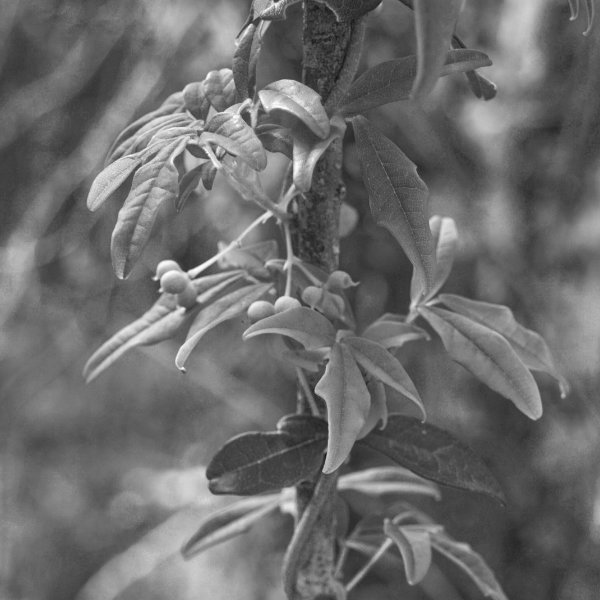“The only man I know who behaves sensibly is my tailor; he takes my measurements anew each time he sees me. The rest go on with their old measurements and expect me to fit them.”
Shaw (1903).
Introduction
Native to Chile’s rainforests, Boquila trifoliolata (B. trifoliolata) is unique in the world of plant deception. Indeed, its deceptive capabilities are so bizarre that the plant has become a source of controversy among the scientists who study it.
B. trifoliolata is a climbing vine that mimics the leaves of other plants. By climbing, the plant reduces opportunities for attack from ground-based herbivores, and by blending-in visually with its host, it further protects itself against leaf herbivores (Gianoli & Carrasco-Urra, 2014).
Most plant mimics replicate the features of one other host plant. B. trifoliolata can concurrently mimic leaves from multiple plants on a single vine — a phenomenon known as mimetic polymorphism. If one of its vines crosses from one host plant to another, different, host, the vine’s leaves change accordingly. B. trifoliolata is also rare for a mimic as it does not predate upon its host(s).
The plant exhibits a high degree of mimetic fidelity, and can replicate 9 out of 11 potential host leaf features, including size, area, length of stalk, angle, and colour. Its leaves can even grow a spiny tip when the vine climbs onto a shrub with spine-tipped leaves (Gianoli & Carrasco-Urra, 2014).
What is perhaps most startling about B. trifoliolata, however, is that it does not require physical contact with a nearby plant to mimic its leaves. The plant can somehow sense its neighbour across an air gap and replicate its features. No known mechanism adequately explains how B. trifoliolata can achieve this mimicry without contact. However, three primary hypotheses exist, all the subject of contentious debate among those who study the plant.
Hypotheses about Boquila trifoliolata’s remote mimicry
The three primary hypotheses which seek to explain Boquila trifoliolata’s remote mimicry capabilities are as follows:
- Volatile organic compounds emitted from host plants’ leaves induce a phenotypic change in nearby B. trifoliolata leaves (Bar & Ori, 2014). B. trifoliolata thereby receives host signals and signatures into its system via scent, which then regulate gene transcription governing leaf morphology.
- Horizontal gene transfer occurs between the host and B. trifoliolata via the airborne movement of bacteria (Gianoli et al., 2021). Horizontal gene transfer involves the movement and incorporation of genetic material between organisms without transmission of DNA from parent to offspring.
- B. trifoliolata possesses a primitive form of eye (ocelli) that enables it to ‘see’ and replicate the structure of nearby leaves via the collection of reflected light (White & Yamashita, 2022). The hypothesis builds on over a century of research suggesting that some plants’ upper epidermis cells have a planoconvex or convex shape that acts as a lens, enabling the convergence of light onto light-sensitive subepidermal cells (e.g., Haberlandt, 1905; Darwin, 1907; Baluška & Mancuso, 2016; Mancuso & Baluška, 2017).
In their experiments, White & Yamashita (2022) placed an artificial, plastic, vine model above living B. trifoliolata plants, ruling out possible signal transmission via volatiles or bacteria (i.e., hypotheses 1 and 2). They found that B. trifoliolata, nonetheless, was still able to replicate the leaves of the nearby artificial plant.
The criticality of adaptation
Boquila trifoliolata demonstrates deceptive adaptability – the ability to detect environmental changes and modify ongoing deception accordingly.
Failure to adapt to environmental change can render deception highly conspicuous against an updated background. Consider the Snowshoe Hare (Lepus americanus), which has white fur in winter and brown fur in summer. The hare’s white fur provides highly effective camouflage during regular winter months, enabling it to blend visually with its snowy background. Global warming, however, is causing winter snow to melt ever earlier. The rabbit’s white fur is thereby rendered highly conspicuous against green and brown vegetation, dramatically increasing its risk of predation (Zimova, Mills,& Nowak, 2016).
Boquila trifoliolata’s ability to adapt its leaf mimicry across multiple host plants enables it to blend seamlessly into a varied and changing background. Whatever the mechanism it uses to mimic the leaves of remote plants, deceptive adaptability across changing backgrounds and contexts appears key to the plant’s survival.
By understanding how plants use deception to their advantage, we can gain insight into the intricate workings of the plant kingdom and the ecosystem as a whole. We can also identify transferable deception principles that have utility in other domains.
Transferable principles
Some emergent deception principles from the study of B. trifoliolata that could enhance deception in other settings include:
- Within the deception planning process, ensure that risk management anticipates and explores potential environmental changes.
- Set aside advance provisions for adaptation, including time and resources.
- During plan execution, monitor covertly the operational environment for changes in people, objects, actions, weather, atmospherics, emotion, and/or other states, etc.
- Covertly use provisioned resources to adapt rapidly to changing environmental conditions.
- Capture lessons identified about the environmental drivers that precipitated adaptation, the degree to which these factors were correctly anticipated, and the success of any adaptation. Ensure that lessons identified are converted into lessons learned by incorporating these insights in future plan development.
References
Baluška F, Mancuso S. (2016). Vision in plants via plant-specific ocelli? Trends Plant Sci. 21:727–730. doi:10.1016/j. tplants.2016.07.008.
Bar, M., & Ori, N. (2014). Leaf development and morphogenesis. Development, 141(22), 4219-4230. https://doi.org/10.1242/dev.106195
Darwin F. (1907). Lectures on the physiology of movement in plants. New Phytol. 6:69–76. doi:10.1111/j.1469-8137.1907.tb06045.x.
Gianoli, E., & Carrasco-Urra, F. (2014). Leaf mimicry in a climbing plant protects against herbivory. Curr Biol, 24(9), 984-987.
Gianoli, E., Gonzalez-Teuber, M., Vilo, C., Guevara-Araya, M. J., & Escobedo, V. M. (2021). Endophytic bacterial communities are associated with leaf mimicry in the vine Boquila trifoliolata. Sci Rep, 11(1), 22673. https://doi.org/10.1038/s41598-021-02229-8
Haberlandt G. (1905). Die Lichtsinnesorgane der Laubblätter. Whilhelm Engelmann.
Mancuso S, Baluška F. (2017). Plant ocelli for visually guided plant behavior. Trends Plant Sci. 22:5–6. doi:10.1016/j.tplants.2016.11.009.
Shaw, G. B. (1903). Man and Superman. A Comedy and a Philosophy. Archibald Constable & Co., Ltd. p.37.
White, J., & Yamashita, F. (2022). Boquila trifoliolata mimics leaves of an artificial plastic host plant. Plant Signal Behavior, 17(1), 1977530. https://doi.org/10.1080/15592324.2021.1977530
Zimova, M., Mills, L. S., & Nowak, J. J. (2016). High fitness costs of climate change‐induced camouflage mismatch. Ecology letters, 19(3), 299-307.


